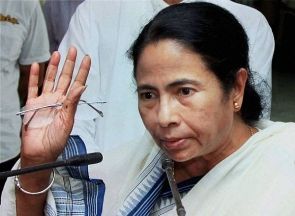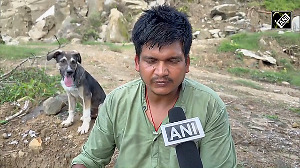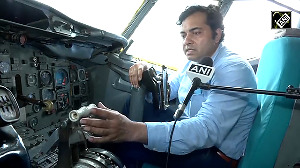 Banerjee along with other regional leaders are likely to play an important role in any future government in New Delhi, so it is in India’s interest that regional leaders like herself realise the importance of progressive economics and good governance, says Tridivesh Singh Maini.
Banerjee along with other regional leaders are likely to play an important role in any future government in New Delhi, so it is in India’s interest that regional leaders like herself realise the importance of progressive economics and good governance, says Tridivesh Singh Maini.
Trinamool Congress chief and West Bengal Chief Minister Mamata Banerjee’s recent visit to Mumbai, during the course of which she had a closed door meeting with top industry leaders including Reliance chairman Mukesh Ambani, Adi Godrej and Yogi Deveshwar may have not drawn the media attention, which similar efforts by other chief ministers do. Yet, it must have surprised many especially her baiters who argue, that not only is she authoritarian and mercurial, but also averse to pro-reform policies essential for economic growth.
Three instances underscore Banerjee’s mercurial nature and gave the impression, that she is obstructionist. The first being her steadfast opposition to a car factory in Singur, which led to the exit of the Tatas from West Bengal in 2008, and the second was her opposition to the Teesta river water treaty which led to the last minute scuttling of the agreement which was to be signed with Bangladesh in September 2011. Finally off course, Banerjee pulled out of the UPA alliance due to her opposition to FDI which was introduced by the government in September 2012.
Yet, the chief minister deserves credit for her recent attempt to reach out to industry, and that too, right after a strong victory in the West Bengal panchayat polls. Mukesh Ambani very aptly stated in this context that, ‘the fact that you have come here within 48 hours of winning the panchayat polls says you mean business.’
What was also significant was the fact, that Banerjee made a strong case for her state being an attractive investment destination. She cited numerous advantages -- geographical and economic -- which Bengal possesses. They include the states proximity to Bangladesh, Bhutan and Nepal as well as the fact that the state will be power surplus in three years. Apart from this, she also mentioned the 10,000 acre land bank for industrial projects. When asked about Singur, the Bengal CM responded by stating that she was not averse to industry, but the rights of farmers cannot be overlooked. This was quite a balanced response from the normally aggressive Banerjee.
Only time will tell, whether her recent overtures to Indian industry, yield any immediate dividends for her state. When asked about the outcome of the meeting with industrialists, Banerjee was cautious stating that, ‘They all are excited and willing to invest in my state, but such things do not happen over one meeting. They will go back and work on their plans’.
Yet, this interaction with the industry is significant for a number of reasons, not just for Banerjee and West Bengal, but for the overall image of regional leaders.
Firstly, it means that the mercurial Banerjee realises that populism or left baiting is not enough to keep her support intact, especially amongst the urban electorate whose support for her played a pivotal role in ousting the Left from the state. The next stage would be some tangible achievements in the economic realm, and this cannot happen without substantial investment and some big industrial projects.
Second, if West Bengal does manage to get some projects, and eventually ends up being another turnaround story like Bihar, Madhya Pradesh, it would drive home the point, that there is not just one economic model, which works, but different ones which are influenced largely by the ethos of a state. This would also add to the current discourse on economic development, which at the moment is very narrow in its approach, and is centered around a few personalities and a limited number of states.
Thirdly, West Bengal is an important state not only historically, but also geographically which could take the lead in acting as a bridge to neighbouring countries, especially Bangladesh, Nepal and Bhutan. Kolkata could thus emerge as an economic hub of eastern India. In addition to this, some of the benefits which accrue to the state, can also spill over to the neighbouring north-eastern states, which have immense potential, but have never really been given the attention they deserve -- though in the last decade the central government has begun to play lip service to the development of the north-east. West Bengal could thus emerge as a sort of geographical gateway between the north-east and the rest of India in this context.
Fourthly, leaders like Banerjee, Naveen Patnaik and Nitish Kumar have been speaking of an eastern club consisting of the poorer states. If Bengal progresses over the next few years, it could be a major player in such a club, and also take up pertinent issues -- political and economic -- pertaining to the north-east, which do not have a strong political or economic voice.
Fourthly, Banerjee’s reaching out towards industry also underscore the point that regional satraps including Banerjee are pragmatic and not blinkered by any economic ideology, in fact they are extremely pragmatic and rational. So while populism may be an integral part of their overall appeal, they realise the relevance of economic growth and pro-reform policies. Other examples of regional leaders who have their flaws, but have made serious efforts to woo industry include Patnaik of Orissa, Nitish Kumar of Bihar, J Jayalalithaa of Tamil Nadu and Sukhbir Singh Badal of Punjab.
Pro-reform moves by regional satraps who are often accused of being the biggest impediment to economic reform would send a strong message to the industry, that a third front government may not be the best option, but will not be the disaster -- as is projected by the national parties and sections of the media.
In addition to this, sections of the urban middle classes too have their apprehensions about the agenda of regional parties. They believe that regional parties have a limited vision and that for the latter ‘inclusive growth’ just means reaching out to their respective vote banks which include religious minorities and the urban poor. This is one of the key reasons why urban middle classes tend to veer towards national parties.
If Banerjee and other regional leaders can also focus on economic growth and reforms and develop an agenda beyond their respective states this may help in changing the perception that they are regressive.
In conclusion, Banerjee who has made a good beginning towards sending signals of being pragmatic should ensure that the recent road show was not a PR exercise, but a serious attempt aimed at removing misconceptions about herself and more importantly her state which has suffered for long, due to abysmal governance and poor economic policies.
At a broader level, Banerjee along with other regional leaders are likely to play an important role in any future government in New Delhi, so it is in India’s interest that regional leaders like herself realise the importance of progressive economics and good governance. Armchair intellectuals who are not comfortable with the rise of regional leaders would do well to accept the rise of regional parties, and also acknowledge the fact that while the latter may be having numerous defects they do have the capacity to adapt to changing circumstances.
Tridivesh Singh Maini is associated with The Jindal School of International Affairs, Sonepat.











